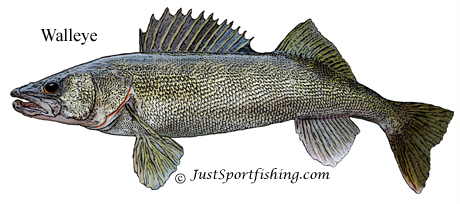|
Home Game Fish Fishing Knots Tackle Tips Videos Pictures Tips Rods & Reels Boats Cook your Catch Articles About Contact |
|
Donate to JustSportfishing.com and help to build the largest fishing information site on the web. Even a dollar or two will keep us building this free site.
|
Walleye World
Record
~ 25 Lbs. Caught at Old Hickory Lake, TN on Aug. 2, 1960 by angler Mabry
Harper Scientific
name
~ Stizostedion Vitreum Other
names
~ Pickerel, Yellow Pickerel, Walleyed Pike, Yellow Walleye, Pike Perch,
Marble eye, glass eye, jack Identification ~ The Walleye has a slender and cylindrical shaped body that ranges from dark olive brown to yellowish gold, its sides often marked with brassy flecks. The walleye is named for its large glossy white eyes, which is caused by the tapetum lucidum, a reflective layer of pigment that helps the fish to see and feed at night or in turbid water. The walleye lacks spots on its dusky dorsal fin, except for a dark splotch at the rear base of the fin. The first dorsal has needle sharp spines and is seperated from the second dorsal fin which is soft rayed. The walleye has teeth that are very sharp. The Walleye's tail is slightly forked and lower tip of the tail is white. Size
~ The size of Walleye is greatly influenced by their environment. Most
angler caught walleye average 1 to 3 pounds and 10 to 18 inches in most
waters, though it occasionally exceeds 10 pounds. Habitat
~ The Walleye prefer water temperatures of 65 F to 75 F. The walleye's
low-light vision and sensitivity to bright light play a large role in
its behavior. They usually feed in shallow water at dawn and dusk.
Walleye are fish-eaters, preying heavily on yellow perch, which cannot
see as well as the walleye in low light and thus are easy prey at night.
With daylight, walleye move into the shadows of cliffs, boulders, logs
and even heavy weeds. Lacking this cover, they seek shelter in deeper
water. Walleye remain more active throughout the day if turbidity, wave
chop or clouds reduce rightness. Walleye may suspend over deep water to
feed on open-water species. Because of its popularity as a game and food
fish, the walleye has been introduced to many lakes in North America,
where it has become established. Feeding
Habits
~ The Walleye primarily consumes other fish that include suckers,
alewives, smelt, shad, shiners, perch, cisco, sculpin, minnows, darters,
and crayfish. The Walleye will also feed on insects such as mayflies.
The Walleye likes to feed in low light conditions.
|


